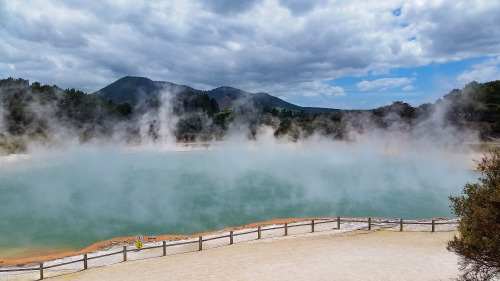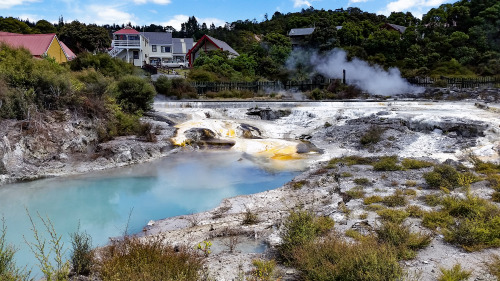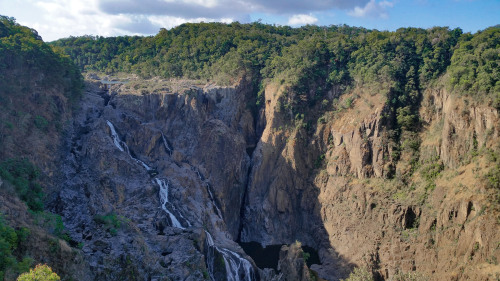#drrock
The Champagne Pool of the Waiotapu geothermal fields is located on North Island, New Zealand. This hydrothermal pool is always steaming as its waters are heated by volcanic activity deep underground. Array of colours in the pool that you can see, come from either arsenic and antimony metal-based minerals or microbial life that can thrive in extremely acidic, toxic and hot environments.
Post link
Dirt + rock + acid + water = mud pool.
A mud pool that developed in a collapsed pit. Slow loss of water by evaporation or reduced recharge from groundwater caused this mud pool to slowly dry out.
Wai-O-Tapu geothermal fields
Post link
Life on the geothermal fields has many benefits and of course fair few downsides too. Hot steam gushing out of the ground during cold winter provides more than just warmth. Locals actually slow cook their dinners over the steam outlets!
In the morning before work, pop a tray with meat and veggies into the steam built on top of the vent, and when you come back from work, dinner is beautifully cooked and ready for you to dig in! Or, if you prefer a boiled food, just put it all in a net and chuck into a hot spring pool for a bit and you got yourself cooked meal.
Hot springs are rich in alkalis and therefore work well as communal baths, which leave your skin clean and healthy. Obviously, communities assign a purpose for each pool, so no one bathes where others cook!
Whakarewarewa Village, New Zealand
Post link
Wave rock around base of the Uluru monolith in Central Australia. An example of erosion-driven sculpting of the bedrock.
Post link
Volcanic gases puffing out of the ground at the Wai-O-Tapu geothermal fields in New Zealand. Main gases coming out of this vent are water vapour and carbon dioxide, however, many other gases can also be present in trace amounts, but this chemistry is dependent on the geological environment. Sulphur is definitely present in this mixture as can be observed by the yellow sulphur crystals forming around the mouth of the vent.
Post link
This mountain face is made of limestones that were deposited on edge of the Indian continent, that was submerged beneath the ocean separating Eurasia and India many millions of years ago. And now, it peaks at more than 5000 metres above the sea level.
Though karst caves are rare in high mountains, this shallow cavern is now a place of worship for Buddhists from the top-of-the-mountain monastery.
Ladakh, India
Post link
Scene from an ancient sea floor, as if it happened yesterday, however, these are from Permian period (~299–251 million years ago). Some of these fossilized bivalve shells are still articulated, meaning, left and right shells are still closed together. This tells you that particular animal specimen was undisturbed since its death, until now. The hard rock that envelops these shells was once a soft sediment in which these molluscs lived.
South coast NSW, Australia
Post link
Collapsed chamber with sulphur coated walls from volcanic gases. Sulphur is picked up from the rocks deep underground by the steam, that was heated by the magma ponding at depths. At the surface, exsolving gases precipitate the sulphur as the gases mix with the atmosphere.
Wai-O-Tapu, New Zealand
Post link
A hollowed out cavern with a rock art covered walls. One of many found around the base of the Uluru monolith in the landscape of Australian outback flatness.
Post link
Coastal cliff erosion can create pillars when rock jointing or faulting are spaced at favourable intervals and angles. These will continue to be sculpted by the waves and often become tourist hotspots (such as the Twelve Apostles in Australia) or a refuge for sea birds, which can nest safely from predators.
Gannet colony at Muriwai, New Zealand
Post link
Inside the plumbing system of an ancient volcano
A fossil plumbing system of an ancient Waitakere Volcano. Though the volcano went extinct and was largely eroded away, the lava flows that once spew from it are now preserved along the Maori Bay coast. The radial feature is an internal view of lava flow lobe that shows rosette style columnar jointing. This feature forms when large lava flow moves and cools slowly, allowing columns to grow, which at the same time are bent due to ongoing lava movement.
Muriwai, New Zealand
A detailed description of this flow is available in the following article:
Bear, A.N. and Cas, R.A.F., 2007. The complex facies architecture and emplacement sequence of a Miocene submarine mega-pillow lava flow system, Muriwai, North Island, New Zealand. Journal of volcanology and geothermal research, 160(1-2), pp. 1-22.
Post link
Barron Falls is a result of plate tectonics at their best. Eastern part of Australia was separated from the current mainland, sinking under the sea, while leaving an escarpment on the mainland. This is the escarpment and it has been eroding since that time. Left are cascades which formed by river flowing over the edge of the escarpment.
Kuranda, North Queensland
Post link
Finke River of Central Australia
This is Finke River which is a dry riverbed most of the time just like many other rivers in the Central Australia. Such rivers flow on the surface during powerful rainfalls, which can turn this dry sand patch into raging torrent. Water does not last long on the surface in the desert areas, and so it either evaporates or soaks into the soil where it then slowly makes its way into the artesian basin (underground water pool, the groundwater system). Actually, the groundwater is a major water source for people living in the dry centre of Australia.
Fun fact!
The upper section of the Finke River was deduced to be around 350 million years old, what makes it one of the oldest rivers in the world. It means it has flown across the continent long before the proto-dinosaurs have even evolved.
Post link
Surface smoothed by grinding practice by people that once occupied caverns around the Uluru.
Post link
Rain droplets preserved in dry desert sand. These tiny impressions, if buried by more sand, can be preserved for hundreds of millions of years and provide geologists with important clue that the rock containing them formed on the surface rather than under water.
In other words, it is a trace fossil of rain.
Post link
Mineral under pressure
This is a photograph of mineral called pyroxene and was taken with a petrographic microscope, and it captures megascale forces of the tectonic processes on the microscale level. This mineral is about 1.5 mm and was found in a rock called greenschist.
This rock is heavily deformed, sheared, due to the force of the tectonic plates pushing against each other. Imagine one plate being a bread and other a knife, and the rock you are looking at is like a butter being smeared on the toast.
The pyroxene is harder than the rest of the minerals in this rock, and so, as the pressure is applied, the other minerals are deformed and squashed against the pyroxene while it remains largely undamaged.
Example from the Nubra Valley, Ladakh, Himalaya
Post link
Leucogranite
Pleasant to look at outcrop along the road in Alice Springs. A leucogranite (white/bright granite) dykes intruded along foliation plane of the gneiss.
Post link




















